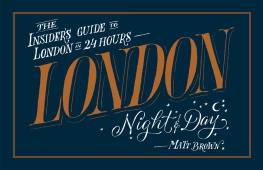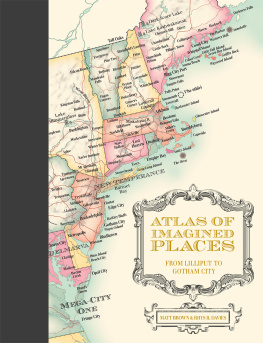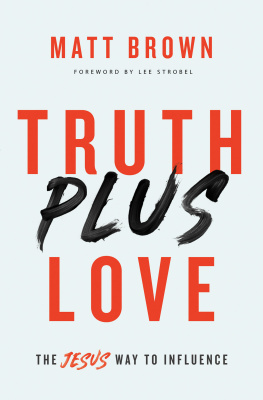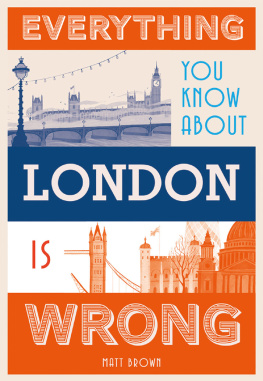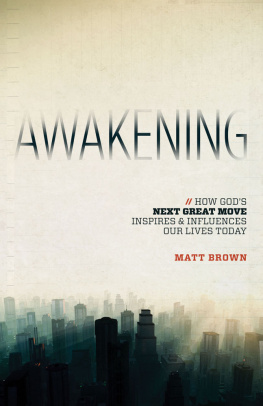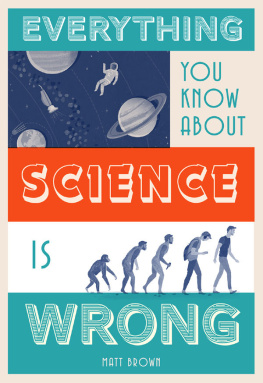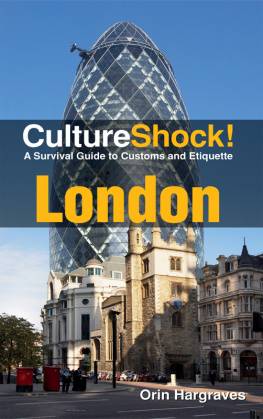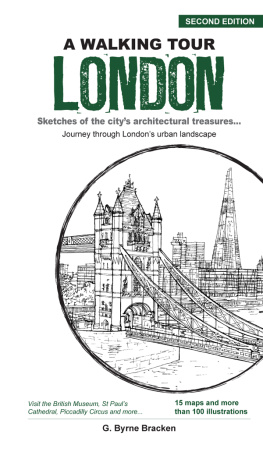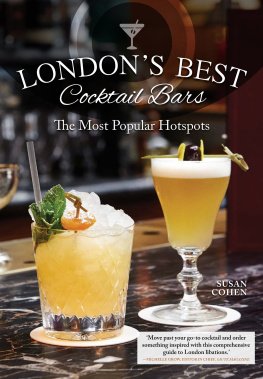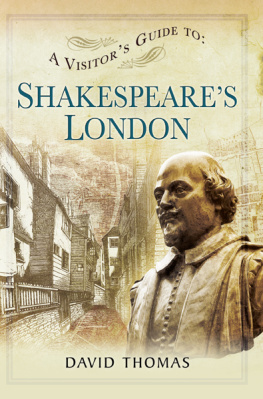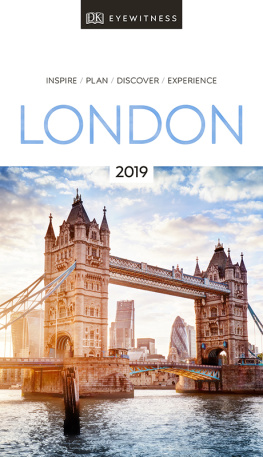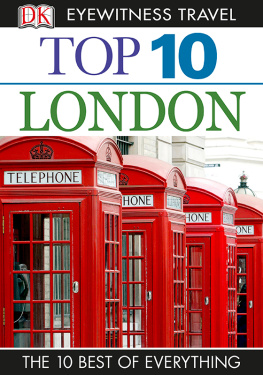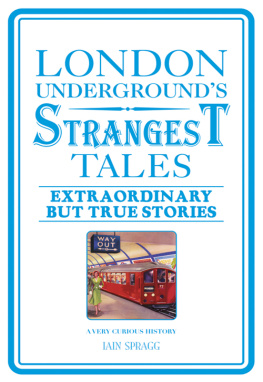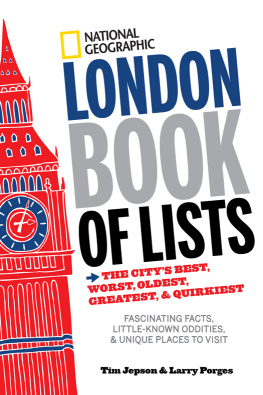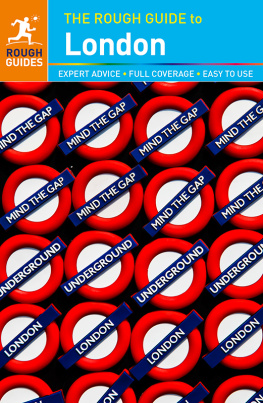LONDON NIGHT AND DAY
LONDON NIGHT AND DAY
THE INSIDERS GUIDE TO LONDON IN 24 HOURS
MATT BROWN

To my nanna, Grace Brown (19252015), who once went to London and refused free chocolate, on the grounds that Were not from round here.
CONTENTS

INTRODUCTION
In 1951, London played host to one of the greatest celebrations in the countrys history. The Festival of Britain reinvigorated a tired, post-war city, spurred redevelopment of the industrial South Bank, and gave visitors a glimpse of a brighter future. Those visitors were not just Londoners. Hopeful pilgrims journeyed from all quarters of the UK, and from overseas. Like all visitors, they needed a guidebook to help them make the most of their time in London. Many were published; few had any longevity. And then theres London, Night and Day illustrated by Osbert Lancaster.

This remarkable guidebook raises eyebrows to this day. For cartoonist Lancaster and his anonymous scribe, the city was not some orderly metropolis to be catalogued and commended. It was a messy, dirty place with plenty of good and plenty of bad. Unlike many guidebooks of the day (and today), the book is filled with opinion and personal observation. Its other notable feature is that it follows the clock twice round, offering insights into the capital at every hour of day and night.

In September 2015, the inner workings of London are shifting gear once more. Five tube lines the Central, Jubilee, Northern, Piccadilly and Victoria will stay open all night on Fridays and Saturdays. The rest will follow a few years hence. This simple change to the transport network will have enormous repercussions for London. At a stroke, it will be much easier to move in and out of the city after midnight, both practically and even more important psychologically.
Although taxis and night buses have always made nocturnal socialising possible, the talismanic lure of the tube will undoubtedly swell the numbers willing to do so. This will inevitably result in a wave of new businesses such as all-night cafs and bars, and a revival of the clubbing scene, currently in the doldrums. Whole new mythologies and folk culture will undoubtedly emerge, as people get used to the horrors and the wonders of the 4am tube.

This seems, then, like the ideal moment to catalogue the 24-hour city as it currently stands (or otherwise). Drawing on Lancasters 1951 volume for inspiration, this book is divided into 24 chapters, each following an hour of the clock, and what one might do within that hour. Of course, a book like this could never encapsulate everything that is possible in London, and simply to write a checklist of the very best would be lazy, when any competent Internet search will fulfil that need. Instead, like Lancasters example, you will find me an idiosyncratic and occasionally opinionated guide. Ill reveal some of my favourite shops, restaurants and bars, but Ill also lead you along dark alleys, through industrial landscapes, and to parts of London you might never have heard of. The fruits of more than a decade exploring and writing about the capital are here caramelised into a collection of insights that I hope you wont find anywhere else. Above all, my aim is to instil a sense of wonder about what this great city offers, at any hour, day or night.
6 a m
DAWN OF LONDON
Have you ever wondered where London came from? The start of the day is as good a time as any during which to contemplate the beginnings of the city.
Those of us who are still living in the capital in 2043 will surely hear all about it. That year will mark the 2,000th anniversary of the founding of the city, and the festivities will no doubt rival Londons other great parties, such as the 1951 Festival of Britain and the 2012 Olympics and Paralympics.
Our city was established and named Londinium by a wave of conquering Romans around 43AD. No one is certain where the name came from, though it is likely to reflect an earlier Celtic origin. Before the Romans, there is no evidence of any sizeable settlement, but thats not to say nobody was here...
DISCOVER LONDON BEFORE LONDON
Its difficult now to imagine the land before the city, but there are places where the ancient landscape asserts itself still. Take a walk along Kings Cross Road, for example, from Clerkenwell towards the terminus. See how the road meanders and twists? Notice how, after a while, the sideroads climb steeply away from you? You are walking along the valley of the River Fleet, and those gradients were cut from the clay many millennia ago. This primeval landscape has made its mark on the buildings as well as the street pattern. When you reach Kings Cross station, seek out the new concourse. Its sweeping saucer shape is no accident. The roof was made this way to fit the curve of the neighbouring Great Northern Hotel (a good place to grab an early morning coffee, by the way). The hotel, in turn, has a curved profile because it follows the turn in the medieval Pancras Road. Why does the road bend at this point? Because it followed the banks of the River Fleet. The engineers who worked on the new concourse didnt know it (I asked them), but their building ultimately takes its modern form because of a river that existed before anyone had heard of stations, or railways, or London. (We might take things back one stage further, by observing that the rivers course would have been determined at the end of the last ice age, when glacial meltwaters first carved out the Fleet Valley; and then to make the connection that the concourse resembles a giant glacier but then we really are straying into the shadiest realms of psychogeography.)
You can find evidence of ancient rivers all over London. The Walbrook once flowed through the heart of Roman London. Its contours are still present in the valley between Ludgate and Cornhill, and a street named Walbrook follows its course. The Tyburn made its way through Marylebone and Mayfair before disgorging into the Thames at Westminster. A cursory glance at a street map readily reveals its meander look for the twisty likes of Marylebone Lane and Bruton Lane, which stand out against the grid-like street patterns of the West End. In south London, the Effra gave shape to Brockwell Park, runs round the boundary of the Oval and bequeathed its name to any number of roads, schools, pubs and cafs. Whole books have been written on the subject. Most of these rivers have long been culverted and turned into sewers visible just at the Thames, where giant floodgates only release them in storm conditions. But they are still down there, waiting for a time when humans have abandoned London, and the ancient landscape can reassert itself.
There are other ancient sites around town, although time and tide have mostly erased the evidence. The Vauxhall and Nine Elms area is particularly noted for its prehistoric finds. A few years ago, timbers from 4,500BC were found in the riverside mud, just next to where the Effra meets the Thames. Whether this was a type of fishing pontoon or an early bridge is debated. You can only see the timbers during the lowest tides each year. Nearby, archaeologists working on the new US Embassy site discovered Paleolithic remains (as far back as 10,000BC) left by hunter-gatherers. Its not uncommon for flint tools of this era to be recovered from the Thames, though it requires a trained eye to interpret them.
Next page
